The criteria used by councils, or charities, when selecting trees to plant often fails to include their usefulness to pollinators. Yet pollinators, especially bees, require forage from early spring through to late autumn, and native trees, including hazel, alder and pussy willow can provide early sources of pollen when few plants are in flower. The advantage of planting native wild flowering trees is that the larvae of many native butterflies and moths rely on tree foliage. However, there are some late flowering non native trees, such as Chinese privet, the bee-bee tree and loquat, which can provide a valuable source of autumn nectar. So it is important that a proportion of non natives as well as natives, are included in a selection of pollinator-friendly trees. If street trees are planted close to community gardens, urban farms, parks and other open green areas, then habitat can be created in those spaces for wild bumblebees and solitary bees, generating pollination streams or 'eddies' between street and garden, farm or park. Trails or 'rivers' of insect pollinated street trees can link these areas of urban forage with one another enabling flying insects to negotiate a less hazardous and a more nutritiously rewarding path through urban areas. |
|
Trees flowering in February |
||
 Acacia
dealbata Acacia
dealbatasilver wattle |
 Alnus
glutinosa Alnus
glutinosacommon alder |
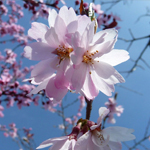 Prunus
x Subhirtelia ‘Autumnalis’ Prunus
x Subhirtelia ‘Autumnalis’Winter flowering Cherry |
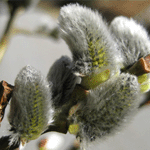 Salix
caprea Salix
capreaPussy/goat willow |
||
Trees flowering in March |
||
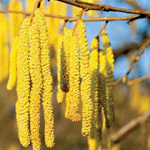 Corylus
avellana ‘common’ Corylus
avellana ‘common’Hazel |
 Corylus
maxima Corylus
maxima Kentish Cob Hazel Kentish Cob |
 Prunus
incam Okame Prunus
incam OkameCherry 'Okame' |
 Prunus
cerasifera Prunus
cerasifera Cherry Plum |
 Prunus
domestica Prunus
domesticaCommon Plum |
|
Trees flowering in April |
||
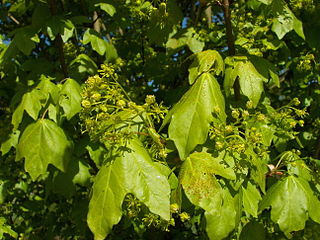 Acer
campestre Acer
campestre Field Maple |
 Amelanchier
lamarckii Amelanchier
lamarckiiJuneberry |
|
|
 Liquidambar
styraciflua Liquidambar
styracifluaSweet gum |
 Malus
sylvestris Malus
sylvestrisCrab apple |
 Prunus avium
Prunus avium
wild cherry |
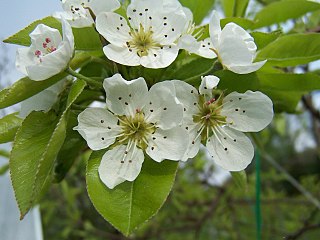 Pyrus communis
Pyrus communis
European Pear |
|
Trees flowering in May |
||
 Acer Acer pseudoplatanuis Sycamore |
 Aesculus Aesculushippocastanum Horse chestnut |
 Crataegus Crataegus monogyna Hawthorns |
 Halesia carolina Halesia carolina Snow drop tree |
 Elaeagnus umbellata Elaeagnus umbellata Autumn olive |
 Sorbus aucuparia Sorbus aucuparia Rowan |
 Cercis
siliquastrum Cercis
siliquastrumJudus Tree |
 Sorbus
aria Sorbus
aria Common whitebeam |
 Ilex
aquifolium Ilex
aquifolium Holly |
 Mespilus
germanica Mespilus
germanica Medlar fruit |
||
| Trees flowering in Feb, March, April, May, June, July, Aug, Sept, Oct | ||
Trees flowering in June |
||
 Tilia europaea Common Lime |
 Ptelea
trifoliata Ptelea
trifoliata Hop tree |
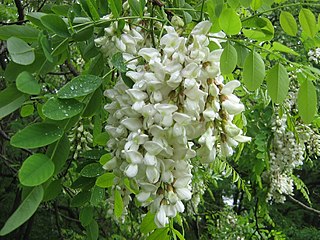 Robinia
pseudoacacia Robinia
pseudoacacia False acacia |
 Robinia
hispida Robinia
hispida Rose Acacia |
 Liriodendron
tulipifera Liriodendron
tulipifera Tulip Tree |
|
| Trees flowering in Feb, March, April, May, June, July, Aug, Sept, Oct | ||
Trees flowering in July |
||
 Castanea sativa Castanea sativa Sweet chestnut |
 Aesculus indica Aesculus indicaIndian horse chestnut |
 Tilia platyphyllos Tilia platyphyllos broad leaved Lime |
 Albizia julibrissin Albizia julibrissin Persian silk tree |
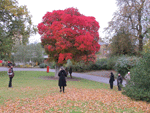 Cotinus obovatus Cotinus obovatus American smokewood |
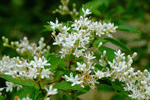 Ligustrum vulgare Ligustrum vulgare Privet tree |
| Trees flowering in Feb, March, April, May, June, July, Aug, Sept, Oct | ||
Trees flowering in August |
||
 Catalpa
bignonioides Catalpa
bignonioides Indian bean tree |
 Eucryphia
glutinosa Eucryphia
glutinosa Brush bush/Nirrhe |
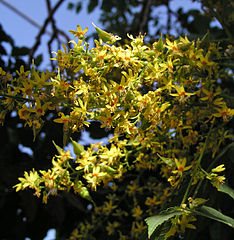 Koelreuteria
paniculata Koelreuteria
paniculata Golden rain |
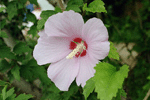 Hibiscus syriacus Hibiscus syriacus Hibiscus |
 Aesculus parviflora
Aesculus parviflora Dwarf horse chestnut or Bottlebrush buckeye |
|
| Trees flowering in Feb, March, April, May, June, July, Aug, Sept, Oct | ||
Trees flowering in September |
||
 Sophora
japonica Sophora
japonica Pagoda tree |
 Tetradium
daniellii Tetradium
daniellii Bee-bee tree |
 Ligustrum
lucidum Ligustrum
lucidum Chinese privet |
 Clerodendrum-trichotomum Clerodendrum-trichotomum Harlequin glorybower |
|
|
| Trees flowering in Feb, March, April, May, June, July, Aug, Sept, Oct | ||
Trees flowering in October |
||
 Eriobotrya
japonica Eriobotrya
japonica Loquat tree |
 Lagerstroemia indica Lagerstroemia indica Crape myrtle |
 Arbutus unedo Arbutus unedo Strawberry tree |
| Trees flowering in Feb, March, April, May, June, July, Aug, Sept, Oct | ||
Plants for Bees and other pollinators |
||
Trees for Bees and other pollinators |
||